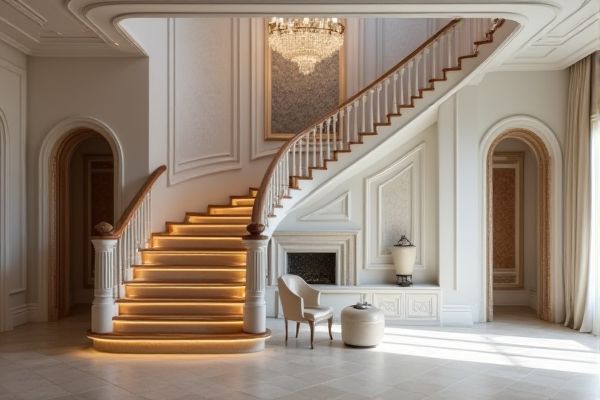
Modern staircases feature sleek lines, minimalist designs, and innovative materials like glass and steel that enhance your home's contemporary aesthetic. Discover the key differences and find out which style best complements your space in the rest of this article.
Table of Comparison
| Feature | Modern Staircase | Classic Staircase |
|---|---|---|
| Design Style | Minimalistic, sleek lines, open concept | Ornate, detailed carvings, closed risers |
| Materials | Glass, metal, concrete, engineered wood | Solid wood, wrought iron, traditional bricks |
| Space Utilization | Optimized for small spaces, floating designs | Requires more space, often bulkier |
| Color Palette | Neutral tones, monochrome, bold contrasts | Rich wood tones, warm colors, classic shades |
| Safety Features | Integrated LED lighting, non-slip treads | Traditional handrails, solid steps |
| Maintenance | Low maintenance, easy cleaning surfaces | Requires periodic polishing, varnishing |
| Cost Range | Moderate to high | Low to moderate depending on materials |
| Typical Usage | Modern homes, commercial spaces, lofts | Traditional homes, vintage restorations |
Introduction to Staircase Design
Modern staircase design emphasizes minimalism, clean lines, and innovative materials such as glass, steel, and concrete, creating a sleek and open aesthetic that enhances contemporary interiors. Classic staircases prioritize ornate details, traditional wood craftsmanship, and curved balustrades, reflecting historical architectural styles and timeless elegance. Both designs serve functional purposes but cater to differing tastes, spatial dynamics, and stylistic preferences in residential and commercial spaces.
Defining Modern Staircases
Modern staircases feature minimalistic designs with clean lines, open risers, and the use of materials like glass, steel, and concrete that emphasize sleekness and lightness. Unlike classic staircases, which often showcase ornate details, wood craftsmanship, and traditional balustrades, modern staircases prioritize simplicity and functional elegance. Your choice in a staircase design can dramatically influence the architectural style and ambiance of your interior space.
Characteristics of Classic Staircases
Classic staircases feature intricate woodwork, elegant balusters, and rich, warm finishes that emphasize traditional craftsmanship and timeless design. They often incorporate detailed moldings, carved newel posts, and symmetrical layouts to create a sense of grandeur and sophistication. Materials like hardwood, wrought iron, and stone are commonly used, reflecting durability and a classic aesthetic that complements traditional architectural styles.
Materials Used in Modern vs Classic Staircases
Modern staircases typically incorporate materials such as glass, steel, and concrete, emphasizing sleek lines and minimalism for a contemporary aesthetic. Classic staircases often use traditional woods like oak or mahogany, combined with wrought iron or ornate balusters, showcasing craftsmanship and timeless elegance. Your choice between these materials influences not only the staircase's durability but also its overall style and integration within your home's design.
Aesthetic Appeal and Visual Impact
Modern staircases emphasize sleek lines, minimalistic design, and materials like glass, steel, and concrete, creating a bold visual statement that complements contemporary interiors. Classic staircases feature ornate details, rich wood finishes, and traditional craftsmanship, offering timeless elegance and warmth that enhance historic or vintage-style homes. Your choice influences the overall ambiance, with modern designs fostering a clean, open feel and classic styles delivering enduring charm and sophistication.
Functional Differences and Space Utilization
Modern staircases prioritize minimalistic design with open risers and sleek materials like glass or steel, enhancing natural light flow and creating an illusion of spaciousness. Classic staircases often feature closed risers with ornate woodwork and balusters, providing a solid visual barrier that can reduce the perception of open space but add traditional elegance. Space utilization in modern staircases typically involves compact, spiral, or floating designs to optimize smaller areas, whereas classic staircases usually occupy more footprint due to wider treads and more substantial handrails.
Installation and Maintenance Considerations
Modern staircases often feature modular components and prefabricated materials that simplify installation and reduce labor time, while classic staircases require skilled craftsmanship and longer assembly due to intricate designs. Maintenance for modern staircases typically involves easy-to-clean surfaces like glass, metal, or engineered wood, minimizing upkeep efforts compared to classic staircases, which demand regular polishing, staining, or repairs to preserve traditional wood finishes. Choosing between these styles impacts both the initial installation complexity and ongoing maintenance requirements, influencing project timelines and long-term costs.
Cost Comparison: Modern vs Classic Staircases
Modern staircases often feature materials like glass, steel, and concrete, which can increase costs due to specialized fabrication and installation requirements. Classic staircases typically use wood and traditional craftsmanship, resulting in varying costs depending on wood type and detailing but often being more budget-friendly. Your choice between modern and classic designs directly impacts your budget, with modern staircases generally demanding higher upfront investment.
Popular Trends in Staircase Architecture
Modern staircases emphasize sleek lines, minimalistic designs, and innovative materials such as glass, steel, and concrete, reflecting contemporary architectural trends. Classic staircases favor ornate woodwork, intricate balustrades, and traditional craftsmanship, often highlighting historical or vintage aesthetics. Popular trends reveal a growing preference for open risers, floating steps, and integrated lighting in modern designs, while classic styles retain their timeless elegance through carved details and rich finishes.
Choosing the Right Staircase for Your Home
Modern staircases feature sleek materials such as glass, steel, and concrete, offering minimalist designs that maximize space and enhance natural light. Classic staircases utilize wood and intricate detailing, creating a timeless and warm aesthetic suited for traditional interiors. Selecting the right staircase depends on your home's architectural style, available space, and desired ambiance, ensuring functionality aligns with visual appeal.
 homyna.com
homyna.com